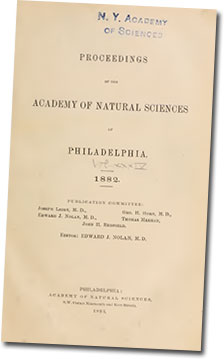![]()
With Pala Presents, we offer selections from the library of Pala International’s Bill Larson, who shares with us some of the wealth of information in the realm of minerals and mineralogy.
 |
On Tourmalines
February 28.
The President, Dr. Leidy, in the chair.
Thirty persons present.
On Tourmalines.—Prof. Leidy said, in absence of other matters of more importance, he would exhibit a collection of tourmalines which belonged to him, and which he thought from their variety would interest the members. He remarked that while black tourmalines are the most common, white ones are rarest. Recently, good-sized crystals of the latter had been found at De Kalb, St. Lawrence Co., New York. From a broken crystal he had obtained a fragment, from which the beautiful gem presented was cut. This is of brilliant form, highly lustrous, transparent, flawless, and nearly colorless, or with only the faintest yellowish tint, like that of a so-called “off-color” diamon1d; and weighs 398 millegrammes. Some remarkable black tourmalines were brought to this city, a couple of years ago, by Lieut. Wm. A. Mintzer, U. S. N., who obtained them at Niantilik, Cumberland Gulf, Arctic America. They are generally three- or six-sided crystals, with a single three- or six-sided pyramidal termination, of various sizes. A large one in Prof. Leidy’s possession is thirteen inches long and one and three-quarter inches at the pyramidal extremity. Perhaps the most beautiful black tourmalines, recently discovered in abundance, are those of Pierrepont, St. Lawrence Co., N. Y. They are remarkable for their perfection; occurring as doubly-terminated crystals, of large size and brilliant lustre. Fine brown tourmalines, often of large size and frequently doubly terminated, with one extremity much modified from the usual form, have also been found in abundance in late years, at Gouverneur, St. Lawrence Co., N. Y. It may be said that this State is pre-eminent for the beauty of its black, white, and brown tourmalines.
The chief localities for colored tourmalines, other than the varieties mentioned, are the Urals, Ceylon, Elba, Brazil and Maine. Of the collection, those from the latter two localities most resemble one another; crystals of the same ordinary tourmaline green color, others of a green color and garnet red-axis, and some with different parts of the prism colored pink and green, of varied depth. The pink is sometimes as delicate as that usual in Elba tourmalines, and sometimes as deep and bright as that of the deepest-hued pink topazes of Brazil. The Maine tourmalines exhibit a wonderful variety of shades of green and red, ranging from the darkest hues to the transparent colorless variety called achroite. The largest and finest achroites seen by Prof. Leidy, have been derived from the Mt. Mica locality.
Among the Maine tourmalines in the collection, chiefly obtained through Dr. A. C. Hamlin, of Bangor, the following were especially indicated:
1. A three-sided prismatic crystal with one end flat, the other a trilateral pyramid, four inches long, and ten lines wide. One half towards the pyramidal end is green, dark and nearly opaque at first, but becoming transparent apple-green; the other half is green on the exterior, but has a garnet-red axis towards the flat end, passing into pale pink towards the middle of the crystal. The specimen is broken into five fragments, a condition quite common in the larger Maine tourmalines, and supposed to be due to the action of frosts.
2. Two fragments of a crystal, an inch and a half in diameter, of a bright, rose-topaz color, becoming nearly colorless and then ending in an apple-green plate, forming a flat termination of the crystal.
3. A fragment of a three-sided crystal, an inch long and an inch and a half wide, consisting of transparent achroite, with one end covered with Cookeite.
4. A dark green three-sided crystal with trilateral pyramid, an inch and a quarter long, and three-fourths of an inch in diameter. The base was occupied with a spherical nodule of achroite, from which was cut a beautiful gem, of brilliant form, flawless, perfectly transparent, and weighing 400 millegrammes. It is nearly colorless, but has a faint pinkish hue.
Among the Brazilian tourmalines were the following:
1. A large, three-sided crystal, with pyramidal termination, rich tourmaline-green, transparent and flawless. It was originally two inches and a half long, and is eight lines wide. From its base a fine brilliant was cut, weighing 5980 millegrammes.
2. Two small green crystals with pyramidal termination, one pale red at the terminal end; the other of the same color at the base.
3. Two large six-sided crystals with flat termination, green externally, with garnet-red axis. One an inch and a half long, and three-fourths of an inch thick; the other an inch and a quarter long, and an inch thick.
4. A rubellite of garnet-red color; a three-sided crystal with pyramidal termination, an inch long, and seven-eighths broad.
Brilliant cut specimens of rose-red tourmaline from Maine and Brazil were alike in color. An Elba tourmaline about an inch in length was six-sided with a three-sided pyramid. The base is yellowish green; the upper extremity pale pink. A Ural rubellite, garnet-red, was six-sided with a six-sided pyramid.